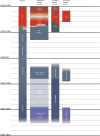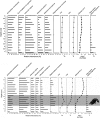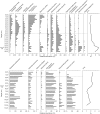Living in an oasis: Rapid transformations, resilience, and resistance in the North Water Area societies and ecosystems
- PMID: 29520749
- PMCID: PMC5963568
- DOI: 10.1007/s13280-018-1034-y
Living in an oasis: Rapid transformations, resilience, and resistance in the North Water Area societies and ecosystems
Abstract
Based on lake sediment data, archaeological findings, and historical records, we describe rapid transformations, resilience and resistance in societies and ecosystems, and their interactions in the past in the North Water area related to changes in climate and historical events. Examples are the formation of the polynya itself and the early arrival of people, ca. 4500 years ago, and later major human immigrations (different societies, cultural encounters, or abandonment) from other regions in the Arctic. While the early immigrations had relatively modest and localised effect on the ecosystem, the later-incoming culture in the early thirteenth century was marked by extensive migrations into and out of the area and abrupt shifts in hunting technologies. This has had long-lasting consequences for the local lake ecosystems. Large natural transformations in the ecosystems have also occurred over relatively short time periods related to changes in the polynya. Finally, we discuss the future perspectives for the North Water area given the many threats, but also opportunities.
Keywords: Fast transformations; High Arctic; North Water; Regime Shifts; Resilience; Resistance.
Figures





Similar articles
-
The history of seabird colonies and the North Water ecosystem: Contributions from palaeoecological and archaeological evidence.Ambio. 2018 Apr;47(Suppl 2):175-192. doi: 10.1007/s13280-018-1031-1. Ambio. 2018. PMID: 29516438 Free PMC article.
-
Historical changes in arctic freshwater ecosystems.Ambio. 2006 Nov;35(7):339-46. doi: 10.1579/0044-7447(2006)35[339:hciafe]2.0.co;2. Ambio. 2006. PMID: 17256638 Review.
-
Climate Change in the North American Arctic: A One Health Perspective.Ecohealth. 2015 Dec;12(4):713-25. doi: 10.1007/s10393-015-1036-1. Epub 2015 Jun 13. Ecohealth. 2015. PMID: 26070525
-
Vulnerability of the North Water ecosystem to climate change.Nat Commun. 2021 Jul 22;12(1):4475. doi: 10.1038/s41467-021-24742-0. Nat Commun. 2021. PMID: 34294719 Free PMC article.
-
Abrupt Change in Ecological Systems: Inference and Diagnosis.Trends Ecol Evol. 2018 Jul;33(7):513-526. doi: 10.1016/j.tree.2018.04.013. Epub 2018 May 18. Trends Ecol Evol. 2018. PMID: 29784428 Review.
Cited by
-
The history of seabird colonies and the North Water ecosystem: Contributions from palaeoecological and archaeological evidence.Ambio. 2018 Apr;47(Suppl 2):175-192. doi: 10.1007/s13280-018-1031-1. Ambio. 2018. PMID: 29516438 Free PMC article.
-
Introducing the North Water: Histories of exploration, ice dynamics, living resources, and human settlement in the Thule Region.Ambio. 2018 Apr;47(Suppl 2):162-174. doi: 10.1007/s13280-018-1030-2. Ambio. 2018. PMID: 29516442 Free PMC article.
References
-
- Agger WA, Maschner HD. Medieval Norse and the Bidirectional Spread of Epidemic Disease Between Europe and Northeastern America: A New Hypothesis. In: Maschner HD, Mason O, McGhee R, editors. The Northern World AD 900-1400. Salt Lake City: The University of Utah Press; 2009. pp. 321–337.
-
- Alix C. A critical resource: Wood use and technology in the North American Arctic. In: Max-Friesen T, Mason OK, editors. The Oxford handbook of the prehistoric Arctic. Oxford: Oxford University Press; 2016. pp. 109–130.
-
- Appelt M. De sidste Dorsetfolk. In: Gulløv HC, editor. Grønlands forhistorie. København: Gyldendalske Boghandel; 2004. pp. 177–200.
-
- Appelt M, Damkjar E, Max Friesen T. Late Dorset. In: Max Friesen T, Mason OK, editors. The Oxford handbook of the prehistoric arctic. Oxford: Oxford University Press; 2016. pp. 783–806.
MeSH terms
LinkOut - more resources
Full Text Sources
Other Literature Sources
Medical
Miscellaneous

